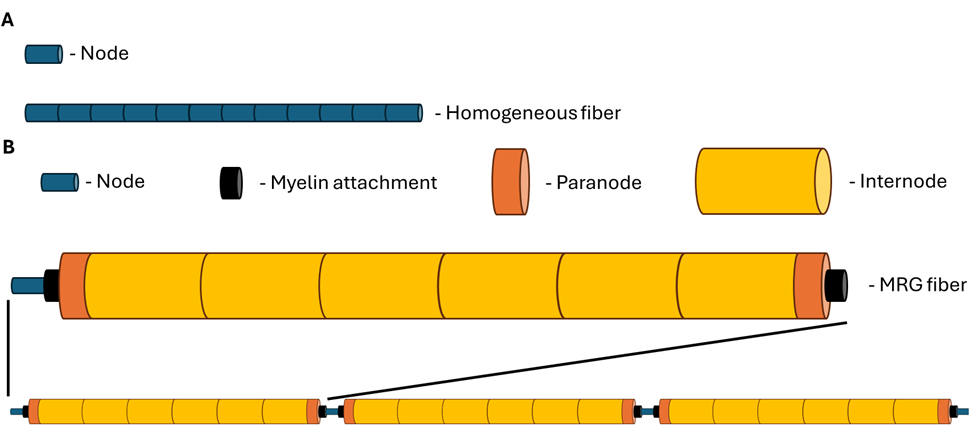Implementations of Fiber Models¶
In PyFibers, we have implemented a number of models describing the ultrastructure and membrane properties of both myelinated and unmyelinated peripheral nerve fibers. Herein we list the available fiber models, and note any changes from the original publications. Unless otherwise specified, the model code was adapted from ASCENT [Musselman et al., 2021]. Validation of the included models and more details on their implementation was documented in the PyFibers paper [Placeholder and Placeholder, 1234].
Myelinated Fiber Models¶
We provide four variants of myelinated fiber models:
MRG Models: Three variants of the McIntyre–Richardson–Grill (MRG) model [McIntyre et al., 2002] for myelinated fibers. The MRG model is a biophysically detailed model of a myelinated nerve fiber, and is widely used in the field of computational neuroscience. The three variants are:
MRG_DISCRETE: The original MRG model, as described in [McIntyre et al., 2002].MRG_INTERPOLATION: An interpolation of the MRG model, which allows for modeling of any fiber diameter between 2 and 16 microns, as described in [Musselman et al., 2021].PENA: A modification of MRG parameters to better replicate the behavior of thinly myelinated fibers, as described in [Peña et al., 2024].SMALL_MRG_INTERPOLATION: Deprecated. Old name forPENA.
Sweeney Model:
SWEENEY: A myelinated fiber model based on the Sweeney model, as described in [Sweeney et al., 1987].
Unmyelinated Fiber Models¶
We provide several variants of unmyelinated C‑fiber models.
TIGERHOLM: A biophysically detailed model of a C‑fiber, as described in [Tigerholm et al., 2014].RATTAY: A simplified version of the Tigerholm model, as described in [Rattay and Aberham, 1993].SCHILD94: A simple model of a C‑fiber, as described in [Schild et al., 1994].SCHILD97: A modification of the Schild 1994 model, as described in [Schild and Kunze, 1997].SUNDT: A modification of the Schild 1994 model, as described in [Sundt et al., 2015].
Construction of Model Fibers¶
Fibers in PyFibers are composed of serially connected NEURON section objects. Sections may or may not be designated as nodes:
Section: A NEURON object which represents a discrete geometric length of a model fiber
Node: A special section that typically represents an excitable portion of a fiber’s geometry (i.e., nodes of Ranvier). Active nodes have nonlinear conductance mechanisms and are thus excitable. Passive nodes have the same ultrastructure parameters, but the nonlinear mechanisms have been removed, and are not excitable. For unmyelinated fibers in PyFibers, nodes and sections are synonymous. See the figure below for an example.

Construction of a model fiber. A) For unmyelinated fibers and myelinated fibers with only one section type (i.e., homogeneous fiber), a fiber model describes a single set of mechanisms and ultrastructure for a node, which is then repeated to the target number of sections. B) For fibers with multiple section types (e.g., MRG as shown), a repeating series of sections with heterogeneous membrane mechanisms and ultrastructure is described from one node until just before the next node. This sequence is repeated to one less than the target number of nodes, and a node is added to the end of the fiber for symmetry. Example shown: MRG model fiber with 4 nodes and 11 sections per node, resulting in a final section count of nsections = (nnodes - 1) * 11 + 1 = (4 - 1) * 11 + 1 = 34. Figure is not to scale.¶
Passive End Nodes¶
When constructing a fiber, users can specify the number of passive end nodes at each end of the fiber. In this case, the fiber is constructed as normal. For end nodes designated as passive, all mechanisms other than extracellular (i.e. the mechanism named “extracellular”) are removed from the node. Then, the following properties are set as described in [Pelot et al., 2021]:
The passive (
pas) mechanism is added to the node.The passive reversal potential is set to the resting potential of the fiber.
The membrane capacitance is set to 1 [uF/cm^2] (a typical value for membranes).
The membrane resistance is set to 0.0001 [S/cm^2] (slightly lower than the typical value, which dulls current entry into the node).
The axial resistivity is set to 1e10 [Ohm*cm] (effectively infinite so that no current flows axially, thereby avoiding the creation of action potentials by restricting current flow to adjacent nodes).